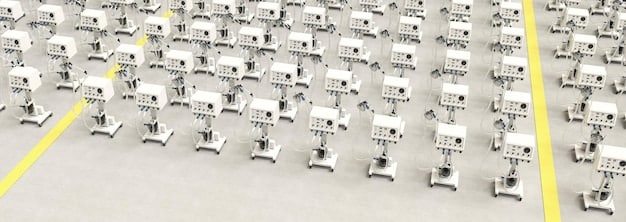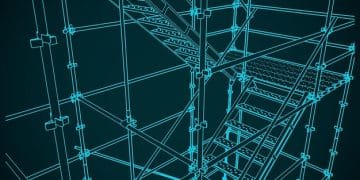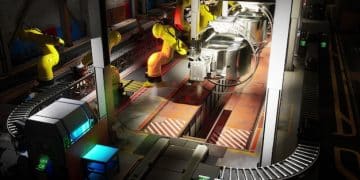Infrastructure Bill Impact on US Manufacturing: Analysis & Opportunities

The Infrastructure Investment and Jobs Act (IIJA) is poised to reshape US manufacturing, presenting both significant opportunities through increased demand and modernization initiatives, and challenges related to supply chain constraints and workforce development.
The Infrastructure Investment and Jobs Act (IIJA), a landmark piece of legislation, is set to inject billions of dollars into revitalizing America’s infrastructure. But what does this mean for the US manufacturing sector? Let’s delve into an insider analysis of the bill’s real impact, exploring the opportunities and challenges that lie ahead.
Understanding the Scope of the Infrastructure Bill and US Manufacturing
The Infrastructure Investment and Jobs Act (IIJA) is one of the most significant infrastructure investments in decades, allocating funds to various sectors like transportation, energy, and broadband. Its impact on US manufacturing is multifaceted, influencing both demand for manufactured goods and the modernization of production processes.
Key Provisions Affecting Manufacturing
Several provisions within the IIJA hold particular relevance for the manufacturing industry, including those related to sourcing requirements and funding for specific projects. Understanding these details is crucial for manufacturers seeking to capitalize on the opportunities presented by the bill.
The “Buy America” Provisions
A cornerstone of the IIJA is the “Buy America” provision, which mandates the use of domestically produced goods in infrastructure projects funded by the federal government. This is intended to bolster US manufacturing by creating a guaranteed market for American-made products.
- Increased demand for US-made materials like steel, cement, and manufactured components.
- Potential for new jobs in the manufacturing sector as production ramps up to meet demand.
- Incentives for companies to invest in domestic manufacturing capabilities.
- Challenges for manufacturers to scale up production quickly and efficiently.

Ultimately, the scope of the Infrastructure Bill’s impact on US manufacturing extends beyond mere financial allocation, fostering an environment for innovation and growth. The key lies in understanding and strategically leveraging its provisions to drive long-term success.
Opportunities Arising from Increased Infrastructure Spending
The injection of federal funds into infrastructure projects represents a substantial opportunity for US manufacturers. From supplying raw materials to producing specialized components, the increased demand translates to potential revenue growth and expansion.
Meeting Demand for Construction Materials
Infrastructure projects require vast quantities of materials like steel, concrete, and asphalt. US manufacturers are well-positioned to benefit from this surge in demand, provided they can overcome supply chain bottlenecks and production constraints.
Supply Chain Resilience
With the increased demand for construction materials and “Buy America” requirements, manufacturers have the opportunity to strengthen and diversify their supply chains. This includes sourcing materials domestically and fostering partnerships with local suppliers.
- Investing in new technologies to increase production efficiency and reduce waste.
- Upskilling the workforce to meet the demands of a modern manufacturing environment.
- Adopting sustainable manufacturing practices to minimize the environmental impact of production.
- Expanding production facilities to meet the growing demand nationwide.
In conclusion, the opportunities arising from increased infrastructure spending extend beyond immediate financial gains, paving the way for a more resilient, innovative, and sustainable manufacturing sector in the US.
Challenges Facing US Manufacturers in Capitalizing on the Bill
While the Infrastructure Bill presents numerous opportunities, US manufacturers also face significant challenges in fully capitalizing on its provisions. These challenges range from supply chain vulnerabilities to workforce shortages and regulatory hurdles.
Supply Chain Disruptions
The increase in demand generated by the IIJA could exacerbate existing supply chain disruptions, making it difficult for manufacturers to access the raw materials and components they need to meet production targets. This issue is further complicated by global events and trade policies.
Workforce Shortages
The manufacturing sector is already grappling with a shortage of skilled workers. The IIJA’s increased demand for manufactured goods will likely intensify this problem, requiring manufacturers to invest in training and recruitment initiatives to attract and retain talent.

Navigating Regulatory Requirements
Manufacturers must navigate a complex web of regulations related to sourcing, environmental compliance, and labor standards. Compliance with these requirements can be costly and time-consuming, particularly for small and medium-sized enterprises (SMEs).
Overcoming these challenges requires a proactive and strategic approach, with manufacturers focusing on building resilient supply chains, investing in workforce development, and engaging with policymakers to address regulatory hurdles. Only then can the US manufacturing sector fully seize the opportunities presented by the Infrastructure Bill.
Strategies for Manufacturers to Maximize Benefits
To maximize the benefits of the Infrastructure Bill, US manufacturers need to adopt proactive strategies that address both the opportunities and challenges presented by the legislation. These strategies encompass innovation, collaboration, and strategic investments.
Investing in Automation and Technology
Adopting automation and advanced manufacturing technologies can help manufacturers increase efficiency, reduce costs, and improve product quality. This includes investing in robotics, artificial intelligence, and data analytics to optimize production processes.
Building Strategic Partnerships
Collaboration with suppliers, customers, and research institutions can help manufacturers access new markets, share resources, and develop innovative solutions. This includes forming joint ventures, participating in industry consortia, and engaging with universities and government agencies.
Focus on Sustainability
The Infrastructure Bill emphasizes sustainability, creating opportunities for manufacturers to develop and market environmentally friendly products and processes. This includes adopting circular economy principles, reducing carbon emissions, and using renewable energy sources.
- Exploring new funding mechanisms, such as public-private partnerships and tax incentives.
- Advocating for policies that support manufacturing innovation and competitiveness.
- Developing comprehensive risk management plans to mitigate supply chain disruptions and other challenges.
By implementing these strategies, US manufacturers can position themselves to capitalize on the opportunities presented by the Infrastructure Bill and drive long-term growth and prosperity.
The Long-Term Outlook for US Manufacturing
The Infrastructure Bill is expected to have a profound and lasting impact on the US manufacturing sector. While the immediate effects will be felt in terms of increased demand and production, the long-term implications extend to innovation, competitiveness, and sustainability.
Increased Competitiveness
By modernizing infrastructure and supporting domestic manufacturing, the IIJA can enhance the competitiveness of US firms in the global market. This includes reducing transportation costs, improving energy efficiency, and fostering innovation.
Reshoring Initiatives
The “Buy America” provisions and other incentives in the IIJA may encourage companies to reshore manufacturing operations to the US, creating new jobs and strengthening the domestic economy. This trend could further bolster the manufacturing sector’s long-term prospects.
Future Innovations
The investments in research and development included in the IIJA can spur innovation in manufacturing technologies and processes, leading to new products, services, and business models. This includes advancements in areas like advanced materials, additive manufacturing, and digital manufacturing.
The long-term outlook for US manufacturing is bright, with the Infrastructure Bill serving as a catalyst for growth, innovation, and sustainability. By embracing change and investing in the future, US manufacturers can secure their position as global leaders in the 21st century.
Case Studies: Early Winners and Losers
While the Infrastructure Bill’s long-term effects are still unfolding, there are already clear indications of which manufacturing sectors are poised to benefit the most and which may face challenges. Examining early winners and losers provides valuable insights into the bill’s nuanced impact.
Early Winners: Steel and Cement Industries
Domestic steel and cement producers have already seen a surge in demand due to the “Buy America” provisions and the need for these materials in infrastructure projects. Companies with modern facilities and efficient production processes are particularly well-positioned to capitalize on this opportunity.
Potential Losers: Manufacturers Dependent on Imported Components
Manufacturers that rely heavily on imported components may face challenges in complying with the “Buy America” requirements, potentially losing out on contracts for infrastructure projects. These companies may need to diversify their supply chains and invest in domestic sourcing to remain competitive.
Specific Project Impacts
Examining how specific infrastructure projects, such as bridge repairs or broadband expansion, are impacting various manufacturing sectors can reveal additional insights. For example, companies that produce specialized components for these projects may experience significant growth.
Understanding the experiences of early winners and losers is crucial for manufacturers seeking to navigate the complexities of the Infrastructure Bill. By learning from these examples, companies can make informed decisions and position themselves for success.
| Key Point | Brief Description |
|---|---|
| 💰 Increased Funding | Bill provides billions for infrastructure projects. |
| 🏭 “Buy America” | Requires use of US-made goods in projects. |
| 🚧 Challenges | Supply chain and workforce issues may arise. |
| 🌱 Sustainability | Focus on eco-friendly manufacturing practices. |
FAQ: The Infrastructure Bill and US Manufacturing
▼
To modernize and upgrade America’s infrastructure by allocating funds to transportation, energy, broadband, and more, creating jobs and supporting economic growth.
▼
It requires that infrastructure projects use domestically produced goods, boosting demand for US-made materials and incentivizing companies to invest in US production.
▼
Supply chain disruptions, workforce shortages, and regulatory compliance can make it hard for manufacturers to fully benefit from the Infrastructure Bill.
▼
By investing in automation, building strategic partnerships, focusing on sustainability and by exploring funding mechanisms, and advocating for supportive policies.
▼
Increased competitiveness, reshoring of manufacturing operations, and spurring innovation in manufacturing technologies enhance future production systems and products.
Conclusion
In conclusion, the Infrastructure Investment and Jobs Act (IIJA) offers a transformative opportunity for US manufacturing. By understanding the bill’s provisions, navigating the challenges, and adopting proactive strategies, manufacturers can unlock significant growth potential and contribute to a more resilient and prosperous American economy. Embracing innovation and building strong partnerships will be particularly crucial for success in this new landscape.





